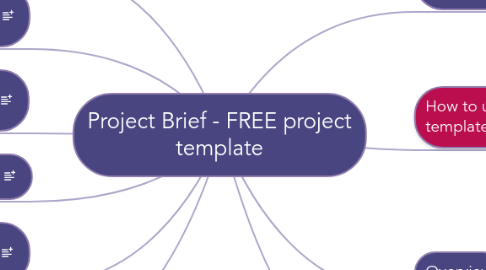
1. Role Descriptions
1.1. [Provide the role descriptions for the project management team and any other key resources identified at this time]
2. Project Management Team Structure
2.1. [Add a chart showing who will be involved with the project]
3. Outline Business Case
3.1. [Give the reasons why the project is needed and the business option selected. This will later be developed into a detailed Business Case during the Initiating a Project process]
4. Project Approach
4.1. [Define the choice of solution that will be used in the project to deliver the business option selected from the Business Case. Take into consideration the operational environment into which the solution must fit]
5. Project Product Description
5.1. [Include the customer’s quality expectations, user acceptance criteria, and operations and maintenance acceptance criteria]
6. References
6.1. [Provide references to any associated documents or products]
7. Sign-up FREE to edit this map
8. Document information
8.1. Project Name
8.1.1. [name]
8.2. Date
8.2.1. [date]
8.3. Release
8.3.1. Draft/Final
8.4. Author
8.4.1. [author]
8.5. Owner
8.5.1. [owner]
8.6. Client
8.6.1. [client]
8.7. Document Number
8.7.1. [number]
8.8. Revision, Approvals & Distribution
8.8.1. Revision History
8.8.1.1. Revision # [....]
8.8.1.1.1. Revision Date
8.8.1.1.2. Previous Revision Date
8.8.1.1.3. Summary of Changes
8.8.1.1.4. Changes Marked
8.8.1.2. Revision # [....]
8.8.1.2.1. Revision Date
8.8.1.2.2. Previous Revision Date
8.8.1.2.3. Summary of Changes
8.8.1.2.4. Changes Marked
8.8.1.3. Revision # [....]
8.8.1.3.1. Revision Date
8.8.1.3.2. Previous Revision Date
8.8.1.3.3. Summary of Changes
8.8.1.3.4. Changes Marked
8.8.1.4. Date of next revision:
8.8.1.4.1. [....]
8.8.2. Approvals
8.8.2.1. Approval # [....]
8.8.2.1.1. Name
8.8.2.1.2. Signature
8.8.2.1.3. Title
8.8.2.1.4. Date of Issue
8.8.2.1.5. Version
8.8.2.2. Approval # [....]
8.8.2.2.1. Name
8.8.2.2.2. Signature
8.8.2.2.3. Title
8.8.2.2.4. Date of Issue
8.8.2.2.5. Version
8.8.2.3. Approval # [....]
8.8.2.3.1. Name
8.8.2.3.2. Signature
8.8.2.3.3. Title
8.8.2.3.4. Date of Issue
8.8.2.3.5. Version
8.8.3. Distribution
8.8.3.1. Distribution # [....]
8.8.3.1.1. Name
8.8.3.1.2. Title
8.8.3.1.3. Date of issue
8.8.3.1.4. Version
8.8.3.2. Distribution # [....]
8.8.3.2.1. Name
8.8.3.2.2. Title
8.8.3.2.3. Date of issue
8.8.3.2.4. Version
9. How to use this template
9.1. How to share this template with your team
9.1.1. Send an email
9.1.1.1. 1. Click Share this map
9.1.1.2. 2. Select Invite People
9.1.1.3. 3. Write a message
9.1.1.4. 4. Click Invite
9.1.2. Send a link
9.1.2.1. 1. Click Share this map
9.1.2.2. 2. Tick Link to share
9.1.2.3. 3. Copy the link to share it
9.1.3. Export
9.1.3.1. 1. Click down arrow, bottom right
9.1.3.2. 2. Select the export option you want
9.2. How to complete this template
9.2.1. Complete the sections in square brackets
9.2.1.1. [....]
9.2.2. Read these sections for help on the template
9.2.2.1. Purpose
9.2.2.2. Advice
9.2.3. Navigate using the links in Contents
9.2.3.1. Contents
9.3. Attribution
9.3.1. Copyright © AXELOS Limited 2009. All rights reserved. Material is reproduced with the permission of AXELOS
9.4. Get this template here
10. Overview
10.1. Purpose
10.1.1. A Project Brief is used to provide a full and firm foundation for the initiation of the project and is created in the Starting up a Project process.
10.1.2. In the Initiating a Project process, the contents of the Project Brief are extended and refined in the Project Initiation Documentation, after which the Project Brief is no longer maintained.
10.2. Contents
10.2.1. The Project Brief should cover the following topics.
10.2.2. Project Definition
10.2.3. Outline Business Case
10.2.4. Project Product Description
10.2.5. Project Approach
10.2.6. Project Management Team Structure
10.2.7. Role Descriptions
10.2.8. References
10.3. Advice
10.3.1. The Project Brief is derived from: A project mandate supplied at the start of the project; Programme management - if the project is part of a programme, the Project Brief is likely to be supplied by the programme, and therefore it will not have to be derived from a project mandate; Discussions with corporate management regarding corporate strategy and any policies and standards that apply; Discussions with the Project Board and users if the project mandate is incomplete or if no project mandate is provided; Discussions with the operations and maintenance organization (if applicable); Discussion with the (potential) suppliers regarding specialist development lifecycles that could be used; Lessons Log.
10.3.2. A Project Brief can take a number of formats, including: Document or presentation slides; Entry in a project management tool.
10.3.3. The following quality criteria should be observed:
10.3.3.1. It is brief because its purpose at this point is to provide a firm basis on which to initiate a project. It will later be refined and expanded as part of the Project Initiation Documentation
10.3.3.2. The Project Brief accurately reflects the project mandate and the requirements of the business and the users
10.3.3.3. The project approach considers a range of solutions, such as: bespoke or off-the-shelf; contracted out or developed in-house; designed from new or a modified existing product
10.3.3.4. The project approach has been selected which maximizes the chance of achieving overall success for the project
10.3.3.5. The project objectives, project approach and strategies are consistent with the organization’s corporate social responsibility directive
10.3.3.6. The project objectives are Specific, Measurable, Achievable, Realistic and Time-bound (SMART).
11. Project Definition
11.1. Explaining what the project needs to achieve. It should include information on the sections given below
11.2. Background
11.2.1. [...]
11.3. Project objectives
11.3.1. [covering time, cost, quality,scope, risk and benefit performance goals]
11.4. Desired outcomes
11.4.1. [...]
11.5. Project scope and exclusions
11.5.1. [...]
11.6. Constraints and assumptions
11.6.1. [...]
11.7. The user(s) and any other known interested parties
11.7.1. [...]
11.8. Interfaces
11.8.1. [...]
